“Bicycling is the most equitable and affordable form of transportation… All of Portland’s citizens already live within a 20-minute bicycle ride of our existing Regional and Town Centers and Commercial Main Streets.”
–From a document produced by PDOT titled Bicycling Into Our Future
Steve Dotterer with the City of Portland Bureau of Planning made a presentation about The Portland Plan at last night’s meeting of the Portland Bicycle Advisory Committee.
According to the official website, The Portland Plan “is an inclusive, citywide effort to guide the physical, economic, social, cultural and environmental development of Portland over the next 30 years.”
The three-year effort is just getting underway, and will ultimately tackle the prodigious task of completely re-analyzing nearly every facet of Portland’s urban design in an attempt to update our city’s Comprehensive Plan and our Central City Plan (which were last updated in 1980 and 1988 respectively).
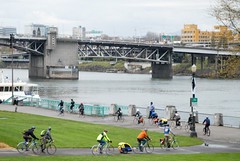
future of not just Portland, but (hopefully)
all American cities.
(Photos © J. Maus)
The importance of this effort cannot be overstated. The policies and principles adopted in the end will lay the groundwork for how we move forward into what is likely to be an era of massive change brought on by increasing population pressure, rising energy costs, and other factors.
So, how do bikes figure into this mix? In many ways.
The people working on The Portland Plan have said the plan will be “developed with community input based on the following critical issues”:
- Climate Change
- Affordability and Accessibility
- Human Health and Safety
- Economic Prosperity and Creative Vitality
- Distinctive and Well-Designed Places
- High-Performing Natural Systems (how to maintain natural areas and ecosystems)
- New Ways and Means (how to pay for the services we need)
Thankfully, PDOT’s bike coordinator Roger Geller (with help from staffer Denver Igarta) is already on the case. Geller has taken each of those critical issues and drafted a summary paragraph on how bicycles relate to them. The resulting, one-page document, Bicycling Into Our Future succinctly answers the question I have posed in the title of this article — Why are bicycles key to the future of Portland?
I share this information not necessarily because it’s news to many of you (most of the points made I have covered in some form previously), but because of the context and format it is written in. These points should be memorized by advocates across the nation, shared with co-workers and bosses, brought up with politicians and candidates, written in letters to editors, blogged about, and so on.
I’ve pasted the text from the document below (emphasis mine) and you can view and download a PDF at the end of this article:
Climate Change & The Environment
Thirty-eight percent of Oregon’s CO2 emissions are attributed to transportation, which is also the fastest rising source. Bicycling can efficiently serve the 60% of trips in Portland that are 3 miles or less. More than immune to rising fuel prices, bicycling is encouraged by it. The City’s and County’s goal is to reduce greenhouse gases to 10% below 1990 levels by 2010. Since 2000, we have dropped our emissions down to 1990 levels.
Further increases in bicycle mode split have the potential to drop emissions by another 5%. Increased bicycling supports a cleaner environment. In fact, the City of Amsterdam’s latest initiative “Cycling to Sustainability” touts how bicycling improves the quality of air and noise in urban areas. A visit to Amsterdam, or any other high bike-use city, provides sensory evidence to this effect.
Affordability and Accessibility
Bicycling is the most equitable and affordable form of transportation. Every year the City expands and enhances what is already an extensive 270-mile network of bikeways. Portland bikeways connect important neighborhood, civic and employment destinations as well as providing seamless links to the regional transit system. All of Portland’s citizens already live within a 20-minute bicycle ride of our existing Regional and Town Centers and Commercial Main Streets.
Human Health
The growing obesity epidemic is threatening the health of millions of Americans. The Center for Disease Control recommends 30 minutes of moderate-intensity physical activity per day most days of the week. The CDC states that “automobile trips that can be safely replaced by walking or bicycling offer the first target for increased physical activity in communities. Portland is perhaps uniquely positioned among US cities to realize this goal.
Economic Prosperity
Portland’s “Green Dividend,” as identified by local economist Joe Cortright, annually keeps $800 million circulating through the region’s economy that would have otherwise left the region. The condition producing the green dividend? We drive less than the national average, and thus spend a smaller percentage of our household income on transportation than do residents of other US cities. The bicycle, as the least expensive form of vehicular transportation allows Portlanders to spend their money in ways that contribute to the vitality of our local economy.
In 2006, bicycle-related economic activity contributed an estimated $100 million and 600 to 800 jobs to the city’s economy. Portland’s “platinum-level” bicycle-friendly reputation is attracting both tourists as well as new bike-oriented businesses and has encouraged Travel Portland and Travel Oregon to promote bicycle tourism to Portland and the PDC to further develop Portland’s burgeoning bicycle industry.
Distinct Places
Bicycles are distinctly Portland! Since bike trips are local in nature they enable interaction between neighbors, strengthen the riders connection to the community, increase the likelihood of shopping locally, place more “eyes on the street”, and contribute to the sense of place. Bicycles function particularly well in compact neighborhoods, where trips are shorter, space is limited, and auto parking is restricted. Lately, the city has focused on developing family-friendly bikeways, called bike boulevards, which appeal to riders of all skill levels. Reducing the negative impacts of traffic on these streets enhances neighborhood livability.
New Ways and Means
Higher fuel prices are encouraging residents to drive less resulting in less gas tax revenue, which is proving an insufficient source of funding to meet our mounting transportation needs. Investing in bicycle infrastructure is a cost-effective means to provide access and mobility. Despite spending less than 1% of Portland’s capital transportation budget on bicycle expenditures, the city has achieved a bicycle mode split ranging between 4.5%-8%. Bicycling truly is Portland’s best transportation buy.
View the document below. Click on it to download a PDF (630k):
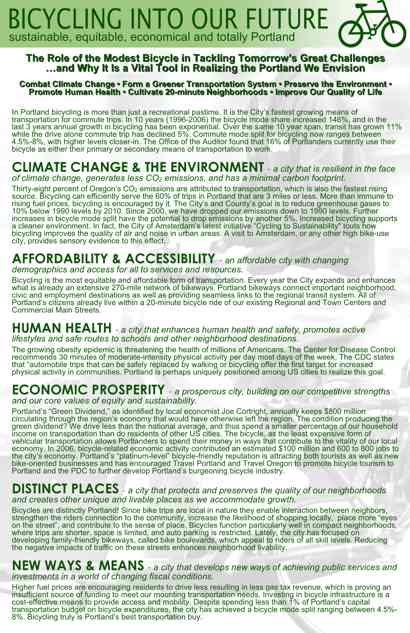
For more on The Portland Plan visit PortlandOnline.com/PortlandPlan and stay tuned for more coverage.

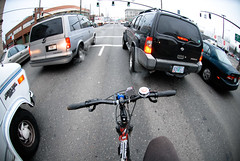
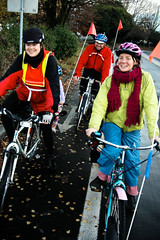
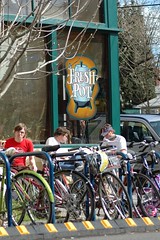
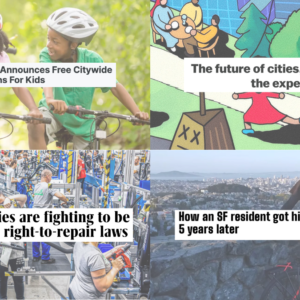
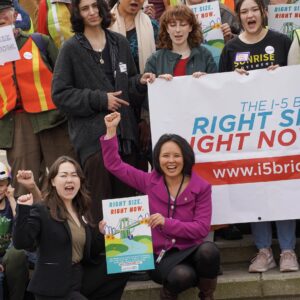
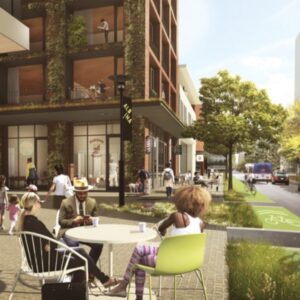
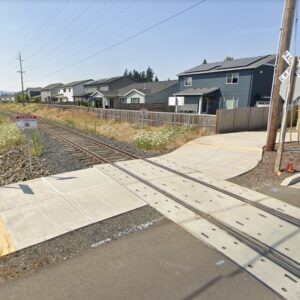
Thanks for reading.
BikePortland has served this community with independent community journalism since 2005. We rely on subscriptions from readers like you to survive. Your financial support is vital in keeping this valuable resource alive and well.
Please subscribe today to strengthen and expand our work.
Wow, fantastic!! Great job, Roger and Denver!
Please consider adding in the Human Health section a piece on the deadly hazardous air pollutant emissions of motor vehicles that are saved by bicycle trips.
I think this bears repeating:
These points should be memorized by advocates across the nation, shared with co-workers and bosses, brought up with politicians and candidates, written in letters to editors, blogged about, and so on.
\”The imortance of this cannot be understated\”
Whoops, I think you meant overstated.
[—Thanks, made the change.]
Thanks Jonathan. To give credit where credit is due Denver was the primary author of this with my help.
Roger
Since all of PDX\’s citizen\’s are a 20 minute ride within downtown or regional centers, does that mean, according to the Jack Bog blog, we are all part of the privliged few?
When they talk about percetages of transportations modes split – what modes are being accounted for?
How do they establish the percentage: accounting for the number of people using that mode; by the estimated number of trips on each mode; or by the estimated total distances being covered through each mode?
good stuff, Denver.
on climate change/environment: a decade ago +/- you\’d here that \”cold starts\” (of autos) were particularly damaging in terms of air pollutant emissions – something like 80% of emissions from a 10 mile trip occur in the first mile.
i no longer see this \”cold start\” damage citied. Have auto pollution controls changed, or..? anyone know? this would obviously be a great arguement for replacing short auto trips with bikes…
RE Diego @6
Others may know more than I on that,
but my understanding is that those numbers are percentages of commuters. They do a count at each of the bridges in town.
Is that correct, anyone?
I guess this only furthers the idea that cycling can be the panacea for nearly all of what ails America.
Now if only the rest of the country would follow suit.
Diogo #6:
Distance doesn\’t play into the calculation. It\’s an accounting of how people commute to work/school. The mode splits include all modes: bike, car, transit, carpool, walk. Also included–depending on the source–are work at home, motorcycle, taxi, etc.
Most of our numbers refer to the commute trip. We have several different sources. These include data from the US Department of Commerce and their decennial US Census and their annual American Community Survey. The question they ask is: \”What was your primary means of transportation to work in the last week?\” In 2006 (or 2007, can\’t recall which and I\’m at home right now) 4.5% of Portlanders said it was the bicycle.
We also have data from the City Auditor, which has been conducting annual resident surveys since at least the 1990s. They ask people their primary and secondary commute vehicle. In 2007 6% of Portlanders identified the bicycle as their primary vehicle and another 10% identified it as their secondary commute vehicle. Not unexpectedly, there was a lot of variation neighborhood to neighborhood. Neighborhoods closer to the central city had between 10-12% of residents identifying the bicycle as their primary commute vehicle and 12-16% identifying it as their secondary commute vehicle. Only 1-4% of residents in neighborhoods further out identified the bicycle as their primary mode and 3-6% identified it as their secondary mode.
Data from both the US Department of Commerce and the City Auditor\’s Office have shown steady increases in bicycle commute mode split over the years. This data is reinforced by our annual bike counts across the city, which demonstrate a similar pattern.
\”Bicycles are the future\” won\’t go anywhere unless we also elect government leaders who understand it and are committed to creating that bridge to the future…
And right now, we\’re in danger of electing a City Council firmly anchored in the 20th century. Fish is so far ahead of Middaugh that he may win outright on May 20th, and Fritz– who wants to represent motorists who feel disenfranchised by bicycle-friendly policies– is positioned to capitalize on an environmental vote split between her two strong opponents.
@11: Amen.
The City of Portland has untold numbers of cool plans that have never been executed for lack of resources. Usually the difference between what gets planned and what gets done is based on political will.
Finally, I would add that the 1988 Downtown Plan called for a 75% transit mode split in downtown. Actual mode split in 2008: 15%.
In Portland almost nothing good happens without a plan, but a plan does not guarantee good things get done.
People who own and drive cars, also vote. I would not call Fish or Fritz \”danger\”.
They are both good solid candidates, and far better than some of the alternatives.
Sure, they may not be \”all bike all the time\” but remember that even a 15% mode split puts bicyclists in the vast minority.
Of course it would be nice to have some large changes on the political landscape, but that is just not how it works. You often have to get the PEOPLE before you can get the POLITICS.
It is more effective to work on getting friends and family to shift their behavior, and as a result the political power will come along with the numbers.
Almost no elected official will go against 75% of the population, except maybe George W. Bush.
A few thoughts:
First -some additions recommended for this document. Fantastically done! It could also include mention the reduction of asthma which is measurably higher near highways, reduced pollution from oil runoff from the streets, more detailed mention of reduced crime (eyes on the street), and mention of reduced need for pavement (heat island effect) as many cyclists who own houses remove the driveway for soil.
I agree with comment #12 that there has been much talk and money spent on plans which have not provided the results promised. While many people look forward to reduced driving with peak oil, the major downside is that we will no longer have money to build any infrastructure (i.e. Sauvie Island bridge move). All construction materials have radically increased in cost, so we can only do outreach and some painting at this point (I welcome Roger\’s thoughts on this).
Lastly, where are the numbers that all of Portland\’s citizens are a 20 minute ride from downtown? I respectfully disagree. Multnomah County extends far into Beaverton and out to east 170th. Even a fit cyclist wouldn\’t be able to make those distances in 20 minutes. Many new riders are significantly slower than the average estimated here.
Thanks for the wonderful work on this article. I\’ll spread it around
This is nice but it is also preaching to the choir. Not only do we need to sell politicians on this but the public as well. If PDOT can start selling bike and transit plans with \”saves money for those that don\’t drive\” and \”eases congestion for those that must drive\” and \”keeps the air cleaner so your kids grow up healthy\” then you will start to see a shift in thinking. You must create a simple, definitive \”WIN/WIN\” that people can understand not just a wonky policy full of buzzwords and vague benefits. I get this but Joe Lunchpail reads this and thinks, \”Just another expensive liberal eco piece o\’ crap!\”, throws it away, and continues to listen to Lars Larson on his truck\’s stereo.
Most bike focused plans have been too esoteric or narrowly marketed to get the majority of voters / taxpayers to buy in. Using language such as \”enabling interaction\”, \”sustainable\”, and \”equitable\” can be easily spun as elistist and privileged whereas \”Bikes create no fumes and their slower speeds make your neighborhoods cleaner and safer.\” is more accessible. Who the hell could argue with that simple message? I\’d love to see Lars argue that asthma and dodging cars is good for kids.
I appreciate the sincere efforts of those that advocate for better bike conditions but the overthinking and academic language is counterproductive in my mind. Take a page from the GOP playbook – keep the message simple and blue collar. That\’s how the doofus-in-chief got elected…TWICE!
Oh yeah, quit invoking Amsterdam all the time. Yes, we cyclists know all about the place but most Americans who have even heard of the place associate it with legal prostitution and hash bars not clean alternative transport. (Look honey, the city council wants our daughter to smoke dope and turn tricks on her bike!)
Thanks Geller for your explanation.
You know, on the topic of “New Ways and Means” one way Portland could pay at least partially for these projects is like they are doing in Japan, where some cities created local complimentary currencies to use the power of communities to circumvent the perceived problem of lack of funds. Search in the internet for eco-money networks or “fureai kippu”.
The community in Portland could agree in accepting a local currency that is issued to pay for services done to build and maintain biking infrastructure. This would not only fit the “New Ways and Means” issue but also every single one of the other points: it would definitely add to the distinctiveness of Portland, would build community and strengthen the local economy by guaranteeing that money will stay in town, etc, etc.
Lack of money is the most indecent excuse for not tackling the problems and challenges we face, especially in such wealthy city like Portland. If politicians are too incompetent to do that, the community itself should act. After all, money is just a convention that we collectively agreed to accept for goods and services – that are other ways to motivate people to work for a collective goal.
The American Community Survey data Roger (#10) mentioned above is from 2006. The
estimates of the percentage of the population that bikes, walks, drives
alone, carpools, or works at home can be parsed by income, gender, race,
age, and more. Very interesting. Check it out at:
http://factfinder.census.gov/servlet/DatasetMainPageServlet?_program=ACS&_submenuId=&_lang=en&_ts=
i actually laughed out loud when i read this: \”All of Portland’s citizens already live within a 20-minute bicycle ride of our existing Regional and Town Centers and Commercial Main Streets.\”
i live out in faaaaaaar SE. i do NOT live w/in a 20-minute bike ride of anything useful, except a freddy\’s and a bike gallery.
eli- well at least you won\’t starve or be unable to get a part.
I live what used to be \”far\” SE (60\’s) and a lot of places are kind of far to walk, but within easy bike range. I thought about living further out for the same reasons I am sure everyone does (the ability to have a bigger house and yard etc.) but I am happy in my shoe box… but when I moved there 5 years ago people were saying stuff like \”wow we will miss you.\”
Here is a funny thing that I have noticed: the more I bike the smaller portland seems. I used to never go downtown when I mostly drove or MAXed, but i will bike down town (rain or shine) on a whim. I think it is because driving in the city is a pain, and I really don\’t like buses, but biking is fun (like playing Frogger), so the trip becomes part of the Adventure. Also for me the extra time on a bike vs driving is ten minutes to far NoPo, and biking is generally faster than the bus. Anyone else get that feeling about bike Portland being smaller than Car/MAX Portland?
duncan: if i lived in the 60s, i would absolutely agree with you! but i have to bike 60 blocks just to get to 82nd. 🙂
Re: #15. If we can\’t invoke Amsterdam anymore, can we at least cite Copenhagen?